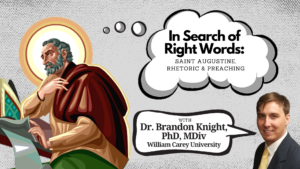 Column Title: In Search of Right Words: Saint Augustine, Rhetoric, and Preaching
Column Title: In Search of Right Words: Saint Augustine, Rhetoric, and Preaching
By Brandon Knight, Ph.D.
William Carey University
Column Description here: Saint Augustine, Bishop of Hippo, in his work On Christian Doctrine, illustrates the important relationship between preaching and rhetoric. Even in his day, many questioned what use the church could possibly gain from the study of oratory. Nevertheless, Augustine saw something much deeper in communication that many Christians still miss centuries later. This column will be a personal journey through Augustine’s On Christian Doctrine, through which he shows how God can, in fact, use rhetoric to help us see more clearly the beauty of scripture as well as find the right words when articulating gospel truths to others.
April-May 2022 / February 2022 / January 2022 / December 2021
Reconsidering our Bible Version and Audience
I have always been fascinated with the numerous versions of biblical translation available. Consider all the various versions of translations in English: KJV, NKJV, NIV, ESV, HCSB, NET, and the list goes on and on. For example, I am certain that my first Bible was KJV. The language was lofty and poetic; but, sadly, often created confusion for me when reading.
After becoming a Christian, I was gifted an NIV Bible, or New International Version. Although I did not at the time realize the rhetorical nature of these different versions per se, I knew that one was easier for me to comprehend and understand. This was no small matter for a baby Christian.
Modern day versions are in and of themselves rhetorical as translators seek to guide contemporary understanding from ancient texts for modern readers.
David S. Cunningham, author of Faithful Persuasion, notes that the choice of language, which often happens subconsciously by speakers and writers, is inevitably the first step in reaching the targeted audience.[1] For example, why do you as a pastor or Bible teacher speak in English to your congregation? Well, because you know your audience’s primary language. In ethnically diverse contexts, however, one must make a conscious choice to reach their audience. We tend not to consider this point, however, when choosing a version when teaching or preaching.
It seems that many Christians miss the forest for the trees when considering biblical versions. For example, many American Christians believe that the King James Version remains supreme among translations. However, at the time of its writing in 1611, even the KJV scribes articulated the need for a translation that would be understandable for the public. More significantly, they even noted the need for a future update as language evolved.
Saint Augustine, however, helps us consider the current-day obstacle by considering God’s plan to reach the linguistic needs of the audience.
Prior to matters of interpretation, he first points out that Scripture’s original translation was from oral to written text.[1] Augustine relates the barrier of language specifically to the fall of Babel, wherein the pride and arrogance of humanity resulted in confusion.[2] Nevertheless, the pride of humanity found healing through divine humility as Christ took on flesh and learned the language of His creation.
Even more, Christ commanded his disciples to do likewise by taking this message of good news to all tribes and—you guessed it—tongues.
Have you ever questioned why the New Testament texts were written in koine (or common) Greek as opposed to Hebrew? Hebrew held historical meaning and primacy in Israel’s history. So, why the shift?
Because the early Church believed Christ’s death and resurrection dealt with the alienation that originated from Eden and widened at Babel, by Christ’s death on the cross for both Jews and Gentiles.[3]
The reason for using koine, or common Greek, is an important one rhetorically speaking because it illustrates the desire for the message to be reached and understood by everyone.
Numerous Christians have taken up the cause of translation for the sake of others. Early Church Father Jerome later translated Scripture into Latin; Martin Luther later translated it into German; and William Carey, the father of modern missions, would eventually translate the Bible into Bengali.
The Christian tradition of translating the Word for others to hear, understand, and know despite their cultural differences is a beautiful one that points to the image of heaven in which God is praised by all tribes and in all tongues (Rev. 5). If Cunningham is right about the first rhetorical choice being one of language, maybe preachers and teachers could learn something about choosing from the plethora of biblical versions at our disposal. If you are looking for the best version, maybe the better question is which version is the best for your audience?
[1] David S. Cunningham, Faithful Persuasion: In Aid of a Rhetoric of Christian Theology (Notre Dame Press, 1991).
[2] “And hence it happened that even Holy Scripture, which brings a remedy for the terrible diseases of the human will, being at first set forth in one language, by means of which it could at the fit season be disseminated through the whole world, was interpreted into various tongues, and spread far and wide, and thus became known to the nations for their salvation” (Ibid., p. 39).
[3] “There is neither Jew nor Greek, there is neither slave nor free, there is no male and female, for you are all one in Christ Jesus” (Galatians 3:28).
